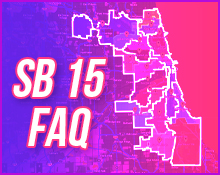American Community Survey (ACS): An ongoing survey conducted by the Census Bureau every month of every year that provides vital information on a yearly basis about our nation and its people.
Census block: The smallest unit of census geography for which population data are reported. Census blocks are designated by the Census Bureau and are generally bounded by physical features such as roads, creeks, or railroads, though in some cases they may be bounded by nonvisible features such as city limits.
Census block group: A cluster of census blocks within a census tract designated by the Census Bureau as a subdivision of that census tract.
Census tract: A unit of census geography defined by the Census Bureau for the purpose of presenting decennial census data. Census tracts are made up of block groups. Their boundaries generally follow visible features, though in some circumstances their boundaries may follow governmental unit boundaries or other nonvisible features.
Coalition district: See the Illinois Voting Rights Act at 10 ILCS 120/5-5: A district where more than one group of racial minorities or language minorities may form a coalition to elect the candidate of the coalition's choice.
Community of interest: Geographic areas, such as in a neighborhood, where residents have common demographic, political, social, and/or economic interests.
Compactness: The degree to which the territory assigned to a district is close together. There are several mathematical ways to measure the elements of compactness.
Contiguity: Adjacency. For redistricting purposes, a district is considered to be contiguous if all parts of the district touch one another at more than a point, so that the entire district is within a continuous boundary. Legal standards governing redistricting for various governmental bodies often require all of the territory in each district to be contiguous.
County election precincts: Geographic units established by county commissioners or courts for the purpose of election administration. The voters in an election precinct usually vote at a single polling place, so the votes cast in the precinct may be counted separately from other precincts.
Crossover district: See the Illinois Voting Rights Act at 10 ILCS 120/5-5: A district where a racial minority or language minority constitutes less than a majority of the voting-age population but where this minority, at least potentially, is large enough to elect the candidate of its choice with help from voters who are members of the majority and who cross over to support the minority's preferred candidate.
Deviation: The amount by which a district’s population differs from the ideal district population for the particular plan type.
Differential undercount: The extent to which one group of persons is more likely to be undercounted in the decennial census than other groups. For example, in the 1990 census, though almost 100 percent of white persons where counted, approximately 5 percent of black and Hispanic persons were not counted. See “Undercount.”
Equal Protection Clause: See “Fourteenth Amendment to the U.S. Constitution.”
Fourteenth Amendment to the U.S. Constitution: The U.S. Constitution provision that includes the Equal Protection Clause, which prohibits the states from denying persons equal protection of the law. The Equal Protection Clause is the primary basis of the one-person, one-vote principle.
Fifteenth Amendment to the U.S. Constitution: The U.S. Constitution provision that the right to vote may not be denied or abridged on account of race.
Fragmentation: The division of a geographically concentrated group, such as a racial or political group, among different districts for the purpose of minimizing the group’s voting strength.
Geographic Information System (GIS): A graphics-based computer system that relates geographic features (such as census tracts, roads, or counties) to data about those features (such as population, race, or income).
Ideal district population: A measure calculated by dividing the total population of the state or other jurisdiction being redistricted by the number of districts in the type of redistricting plan being considered.
Influence district: See the Illinois Voting Rights Act at 10 ILCS 120/5-5: A district where a racial minority or language minority can influence the outcome of an election even if its preferred candidate cannot be elected.
Method of equal proportions: The mathematical formula used as provided by federal statute to reapportion congressional seats among the states after each decennial census.
Minority vote dilution: The creation of districts that either (1) divide members of a racial or ethnic minority group among several districts, artificially reducing the group’s opportunity to influence elections (see “Fragmentation”) or (2) place extraordinarily high percentages of members of a racial or ethnic minority group in one or more districts, so that minority voting strength is artificially limited to those districts and is minimized in neighboring districts (see “Packing”).
One Person, One Vote: The principle that each person’s vote should count equally to every other person’s vote, which is effected by the allocation of the same or substantially the same population to each district of a particular type, such as a congressional district. The courts derive the One Person, One Vote standard primarily from the Equal Protection Clause of the Fourteenth Amendment to the U.S. Constitution. For congressional districts, the one person, one vote requirement also derives from Section 2, Article I, and from Section 2 of the 14th Amendment to the U.S. Constitution.
P.L. (Public Law) 94-171: The federal statute that requires the Census Bureau to provide, by April 1 of each year following a decennial census, the population and race data necessary for redistricting.
Packing: Creating a district with a very high concentration of a particular group of voters, such as a racial or political group, tending to result in the election of the group’s candidate of choice in any election in that district and the dilution of the group’s voting strength in neighboring districts.
Population estimates: An approximation of the population of a geographic unit at a point in the past or present for which an actual population count is not available.
Population projections: An approximation of the population of a geographic unit at a point in the future based on specific assumptions regarding future demographic trends in the geographic unit.
Racial minorities or language minorities: The same class of voters who are members of a race, color, or language minority group receiving protection under the federal Voting Rights Act.
Racially polarized voting: The term used to describe circumstances in which the voting preferences of a racial or ethnic group consistently vary from those of other racial or ethnic groups, particularly when the different voting preferences are based on the race of the candidate. Also referred to as “racial bloc voting.”
Reapportionment: Reallocation of a fixed number of seats in a governmental body among established political units. Following each decennial census, the seats in the U.S. House of Representatives are reapportioned among the states. The result is that each state is assigned its number of congressional seats for the next decade. Reapportionment does not result in the establishment of new district boundaries. The term is sometimes used imprecisely to mean “redistricting.”
Redistricting: The process of redefining the geographic boundaries of individual election units such as legislative or congressional districts or county election precincts.
Retrogression: The term used to describe a reduction in the voting strength of a racial or ethnic group resulting from a redistricting plan or other change in election procedures. Retrogression is the primary test used for evaluating a change in election procedures under Section 5 of the Voting Rights Act.
Statistical sampling: The statistical method by which characteristics of a small group are measured and applied to the population as a whole.
Topologically Integrated Geographic Encoding and Referencing System (TIGER): The cartographic map database, prepared by the Census Bureau, that Illinois will use as the geographic database for redistricting.
Total range of deviation: The range over which the populations of all districts in a redistricting plan deviate from the ideal district population.
Traditional districting principles: A term often used to refer to criteria, such as compactness and contiguity that have historically been considered in drawing election districts.
Undercount: The error in census data that results from the failure to count some persons or housing units in the decennial census. Historically, certain groups, such as members of racial or ethnic minorities, have been disproportionately undercounted by the federal census.
Voting-age population: The number of persons in a geographic unit who are at least 18 years of age. Because some population groups, such as racial or ethnic minorities, tend to be younger on average than the population as a whole, the voting age populations are frequently compared in evaluating the potential voting strength of those groups.
Voting Rights Act: The federal law prohibiting discrimination in voting practices on the basis of race or language group, codified as 42 U.S.C. Section 1973 et seq. The official title of the Act is the Voting Rights Act of 1965. Sections 2 of the Act are important for redistricting.
Section 2: Prohibits the adoption of voting standards or practices that abridge the right to vote on the basis of race or language group. This section applies to all states and other governmental units and may be used to challenge a redistricting plan that discriminates against a racial or language minority group.
Voting tabulation district (VTD): The census geographic equivalent of a county election precinct, created for the purpose of relating election data to census data. These VTDs often differ from actual election precincts because election precincts do not always follow census geography. During the approximation process that creates VTDs, county election precinct boundaries that do not follow census geography are assigned to the nearest census block boundary.











